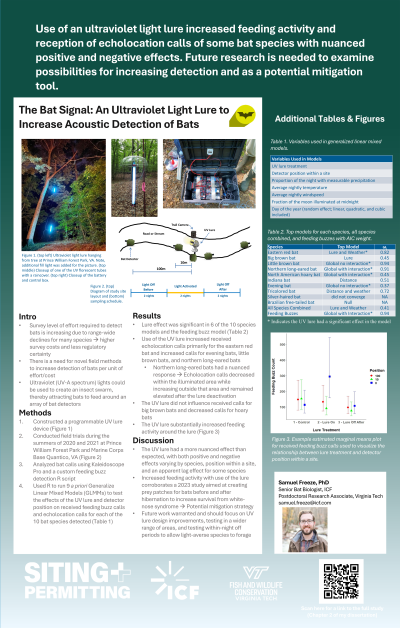The Bat Signal: An Ultraviolet Light Lure to Increase Acoustic Detection of Bats


Samuel R. Freeze, PhD (he/him/his)
Senior Bat Biologist
ICF
Palmetto, Florida
Poster Presenter(s)
Widespread mortality of bats due to White-nose Syndrome (WNS) in North America is leading to increased difficulty in completing pre-construction and clearance surveys for imperiled bat species. This is due to lower detection probabilities of both mist-net and acoustic surveys. Lure technology shows promise to increase detection while decreasing sampling effort and survey cost. However, research has primarily focused on increasing physical captures during mist-net surveys using sound lures. Because many bat surveys are now performed using acoustic detection, there is a similar need to increase detection probabilities during acoustic surveys. Ultraviolet (UV) lights have anecdotally been shown to attract insect swarms and thereby attract bats for observational studies as well as experimentally provide a food source for WNS-impacted bats before and after hibernation. Therefore, a field-portable and programmable UV lure device was constructed and tested to determine the value of lures for increasing acoustic detection of bats. Using a before, treatment, after experimental design, the lure device was tested to assess if the device increased both echolocation calls and feeding activity at an array of bat detectors. The lure resulted in a substantial increase of feeding activity around the UV light and had a nuanced, species-specific and positional-dependent effect on echolocation calls received. The UV lure increased echolocation calls for the eastern red bat (Lasiurus borealis), little brown bat (Myotis lucifugus), and evening bat (Nycticeius humeralis) whereby decreasing calls of the North American hoary bat (Lasiurus cinereus). The northern long-eared bat (Myotis septentrionalis) showed a negative response within the illuminated area but increased echolocation activity outside the illuminated area during lure treatment and activity was elevated at all positions after the lure was deactivated. This study demonstrated the potential utility of ultraviolet light lures to increase feeding activity and acoustic detection of bats during pre-construction and clearance acoustic surveys.
